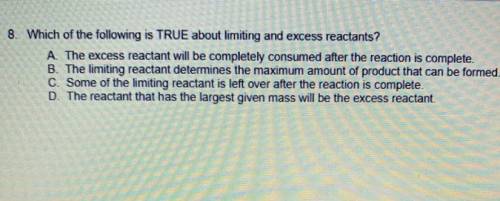
Chemistry, 09.03.2021 08:40 chocolate1294
8. Which of the following is TRUE about limiting and excess reactants?
A. The excess reactant will be completely consumed after the reaction is complete
B. The limiting reactant determines the maximum amount of product that can be formed
C. Some of the limiting reactant is left over after the reaction is complete.
D. The reactant that has the largest given mass will be the excess reactant.


Answers: 3


Another question on Chemistry

Chemistry, 21.06.2019 17:10
Nitric oxide (no) can be formed from nitrogen, hydrogen and oxygen in two steps. in the first step, nitrogen and hydrogen react to form ammonia: n2(g) + 2 h_2(g) rightarrow 2 nh_3 (g) delta h = -92. kj in the second step, ammonia and oxygen react to form nitric oxide and water: 4 nh_3(g) + 5 o_2(g) rightarrow 4no(g) + 6 h_2o(g) delta h = -905. kj calculate the net change in enthalpy for the formation of one mole of nitric oxide from nitrogen, hydrogen and oxygen from these reactions. round your answer to the nearest .
Answers: 1

Chemistry, 22.06.2019 07:30
In a reaction (at equilibrium) that makes more moles of gas than it consumes, what is the effect of increasing the pressure?
Answers: 1

Chemistry, 22.06.2019 10:10
How do you identify the anode on a power source such as a battery? how do you identify the cathode? how are terms anion and cation?
Answers: 1

Chemistry, 22.06.2019 15:30
Draw the lewis dot structure for each of the following polyatomic ions
Answers: 1
You know the right answer?
8. Which of the following is TRUE about limiting and excess reactants?
A. The excess reactant will...
Questions




Mathematics, 05.05.2020 21:04



Biology, 05.05.2020 21:04

English, 05.05.2020 21:04


Mathematics, 05.05.2020 21:04

Mathematics, 05.05.2020 21:04



SAT, 05.05.2020 21:04


Mathematics, 05.05.2020 21:04


Mathematics, 05.05.2020 21:04


Mathematics, 05.05.2020 21:04



